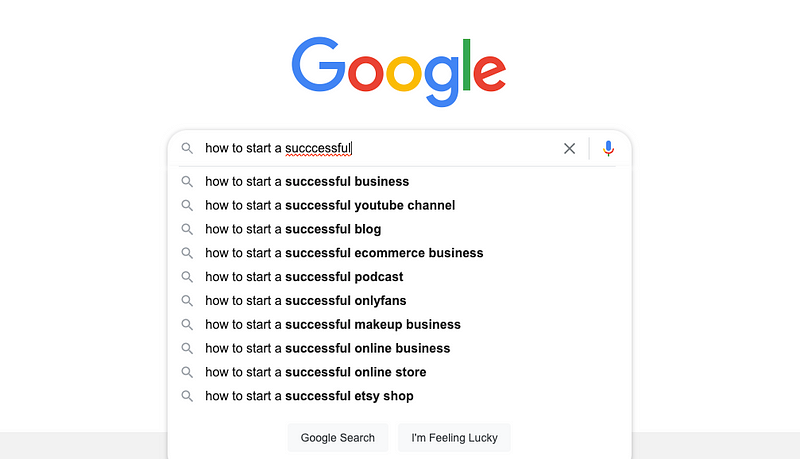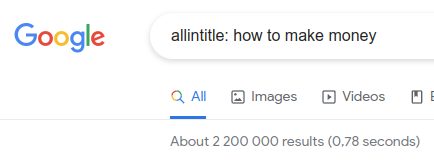I built a blog with 200k+ monthly visits in under a year—without doing any SEO.
This is a comprehensive guide on how to build a blog without SEO. As it turns out, you will grow your blog much faster by ditching SEO advice.
SEO—You Don’t Need It to Build a Successful Blog
SEO stands for Search Engine Optimization. It is one of the 21st-century buzzwords with a lot of hype.
But is SEO really needed?
To put it short, SEO involves domain knowledge coupled with expensive tools, backlink building, and strategic keyword insertion. The general belief is if you don’t do SEO, you can’t rank high on search engines.
If you are a blogger who worries about SEO, I bet you love this article.
These days, you don’t need to know what SEO means to build a successful blog. As a matter of fact, you will grow your blog way faster by ditching all the SEO advice and tools.
All you need to do is write informative and user-friendly content. After a couple of months of hard work, you start seeing your traffic go up.
From 0 to 200k+ Monthly Visits
I grew my website from 0 to 200,000+ monthly visits in less than a year during 2021–2022.
Now I’m making a full income from affiliate marketing, freelancing, and advertisements on my blog.
For the sake of clarity, I’m not talking about a Medium.com blog. Instead, I have my own website I’ve grown.
To build this big of an audience, I only focused on writing quality content. Nothing else.
So my blueprint for blogging success has:
- No SEO
- No expensive tools
- No previous experience in blogging
- No backlink building/outreach
- No pre-built audience
- No content outsourcing
- No guest posts (no writing nor accepting)
- No promotion on social media
All you need to do is solve readers’ problems by writing comprehensive guides.

Disclaimer: Building a successful blog takes a lot of time. I have spent 30–50 hours writing every week for the better part of the past year. If you are serious about blogging, you have to spend tens of hours writing every week. To create a blog as a small side hobby, I recommend skipping this article.
Let’s start by looking at how you can come up with a great blog post topic.
How to Come Up with a Blog Post Topic?
To write a successful blog post, you need to provide value to the searcher. To do this, you need to answer their question or solve their problem.
Treat each blog post like a micro business. A successful blog post is like a successful product. It needs to solve a problem—better than anyone else does.
Not understanding this is a common mistake.
A lot of people write about random topics they came up with. Unfortunately, this style of blogging doesn’t work anymore. If you are starting a new blog, you need to provide value to your readers. Otherwise, you won’t be able to get traffic.
Before writing a blog post, you need to find a topic that people are searching for.
You heard it right—you shouldn’t come up with the topics. Instead, you should find a topic based on what readers want.
And no, you don’t have to be an expert. Just don’t pretend to be one! You can write a great article even if you have no expertise in the topic. All you need is to do some research and put it in your own words.
But how do you know what people are searching for?
You can use Google’s own data—for free.
The Chrome Incognito Trick
Unfortunately, you don’t have an access to Google’s search volumes. Google doesn’t make those publicly available, so it’s not possible to know how many times something is searched.
But you can access Google’s data another way.
If you’re a Chrome user, open up Google Incognito mode.
Head over to Google Search and start typing something.
For example, let’s start typing “How to start a successful…” to see what Google suggests:

There are lots of suggestions. These are search phrases Google thinks you are about to search.
These suggestions are not random guesses. Instead, they are predictions of what you are most likely about to search. The suggestions are based on Google’s own search data.
If you didn’t get it, the suggestions are good candidates for your next blog post topic.
Anytime Google suggests something this way, there is at least some search volume for that search phrase.
Fun fact: I never come up with blog post topics myself. Out of the 300+ blog posts I’ve written, 98% of the topics were suggested by Google.
From this point on, only write about topics that Google suggests. As a byproduct, this strategy also solves the blank page syndrome. You don’t have to be creative because you don’t come up with the topics yourself.
But not all suggestions make great topics for a blog post.
This is because there could be a lot of competition.
Depending on the niche, you may end up competing with millions of more experienced bloggers. This is why you should target less competitive long-tail search phrases.
Target Long-Tail Search Phrases
When you have found a potential topic for a blog post, check how many similar posts there are.
First of all, use common sense.
Writing a blog post about “Fitness” is a bad idea. This niche is super competitive and has been around for a long time. There are millions of fitness blogs you are competing with. In other words, there is no chance to rank high for that search phrase.
As a beginner blogger, narrow down the niche by targeting long-tail search phrases.
For example, instead of “Best hotels”, consider “Best hotels for couples visiting Helsinki”.
This way you narrow down the competition to improve your chances of ranking high.
To get a ballpark estimation of the competition, use Google’s advanced search operator called “allintitle:”.
For example, let’s check how many blog posts cover the topic “How to make money”:

There are over 2M blog posts on “how to make money”. This is a way too competitive topic for an article.
As a comparison, let’s check how many articles there are about “How to start a Medium blog”:

As you can see, there are only ~200 results. There is much less competition compared to the money-making topic. This suggests it is a great blog post candidate.
But how do you beat those 213 articles?
To put it short, you need to write the most informative and the longest article around the topic.
The next chapter explains how to do it right.
How to Write a Blog Post That Ranks High?

It’s time to start writing your first blog post.
I want you to forget the word “SEO” and replace it with “reader-friendliness”.
Don’t write for robots. Write for humans.
To rank high, you need to write articles that solve the reader’s problem. Treat each article as a product. Make it so good that the reader doesn’t need another one.
Here is a list of 10 writing tips to write an article that ranks high.
1. Make the Articles Comprehensive
This is the most important part of making your article rank high. You need to write comprehensive guides, usually 2,000+ words in length.
- Make sure to leave no stone unturned. Besides answering a single question, answer all closely related questions that might benefit the user.
- Write complete guides. Make sure the reader doesn’t need to read any other articles than yours.
- To rank #1 on Google, your article must be the best match for a search query. This usually means it has to be the longest article too!
The level of competition is easy to check. Search for your search query in Google, and open up the top 10 result pages. Then write a more comprehensive (and longer) article than any one of those top 10 results.
I know it’s not easy, but this is what it takes!
Fun fact: My blog posts are rarely less than 2,000 words in length. Some of the blog posts I write are as long as 5,000–10,000 words in length.
To produce a 2,000+ word post easier, split it into smaller sections. If you split the article into 10 subsections, you reduce the task to writing ten 200-word articles. This not only streamlines the writing process but also makes it easier for the readers.
For example, let’s say you are writing a 2,000-word article on “How to Prepare for a Tennis Match”.
Here is an example of a content outline:
- Tennis Rules Recap (Subsections for 1 vs. 1 and 2 vs. 2)
- How Long Does a Match Last?
- What pack into your backpack? (Subsections for outfit, racket, first-aid kit, sunscreen, hydration, and so on)
- What to Eat Before a Match?
- How Long Before the Match Should You Eat?
- What to Drink Between Rounds?
- What If My Racket Breaks?
- What If I Get Sick Before the Game?
- What If My Opponent Doesn’t Show Up?
I’ve never played a real Tennis match. Yet I was able to come up with a bunch of useful subheadings to simplify the writing process. This is to show you can do it too!
If you can’t come up with subheadings, you can always use the Incognito trick again. Open up Google Search and start typing something relevant to your article to see the suggestions. Use the suggestions as subheadings. Just make sure they make sense in the context of your article!
2. Write Evergreen How-to Guides
How-to guides are hot. People are always looking for information on the Internet.
Write comprehensive how-to guides that solve a particular problem for the reader.
Also, make sure the topics are evergreen.
For example, “how to spin a fidget spinner” is a bad topic because it’s not evergreen. Fidget spinners were a trend that died down quickly.
A good example of an evergreen topic would be something like “How to calculate the Pythagorean theorem”. This guide will always be relevant as the way to calculate the theorem will never change.
3. Use Plain Language
Don’t try to outsmart your reader. Use plain and simple language. Try to write for an eighth-grader.
Put yourself in the reader’s shoes. Nothing is more frustrating than hard-to-read sentences with tricky words. Don’t use fancy words. Those will only make the stories hard to read.
Write short and concise sentences. Don’t make a phrase extend over multiple lines.
To enforce these rules, there is a free tool called Hemingway Editor.

This tool warns you about:
- hard-to-read sentences
- excess words
- passive voice
And more.
Also, you can use a tool like Grammarly to fix grammar issues.
The free version of Grammarly is more than enough. Grammarly scans your content as you write. It makes real-time suggestions to improve it.
4. Use Clear Structuring
Use headings, subheadings, and sub-subheadings as necessary. This makes your writing job easier as stated earlier. Besides, you make the article skimmable for your busy readers.
If someone is in a hurry, they don’t have to spend time trying to find the answer. Instead, they can quickly scroll through your article using the headings as road signs.
5. Make Every Word Count
Don’t add excess jargon to your articles. Instead, make every word count.
Previously, you learned that the article must be comprehensive and long to rank high. But make sure to keep nonsense out of the articles.
If a sentence doesn’t contribute to solving readers’ problems, leave it out.
Your goal is to deliver the message as quickly as possible. The less time a reader has to spend looking for the answer, the better.
6. Use Illustrative Images
No one wants to read a wall of text. To avoid this, add illustrative images to the content.
Illustrative images can also support learning. When great content is coupled with a useful image, it can be a powerful learning experience.
Also, adding stock images here and there enhances the visual appearance of the article.
Tip to using images: Try AI text-to-image generators. You’ll be impressed!
If you don’t have images of your own, feel free to use images from Unsplash. These images are royalty-free. You can use the images however you like. Remember to credit the author of the image!

7. Add Links to Useful Resources
If you found an article that could be of interest to your user, link to it. This way you provide even more value to your user.
Also, remember to link to your own articles where it fits naturally!
By using links, you build trust. It shows the reader you’ve done proper research on the topic.
If you have your own articles to link to, that’s even better. Besides providing value to the reader, you can make them stay longer on your site.
8. Remember Mobile-Friendliness
People read blog posts with their smartphones.
Nothing is more frustrating than a tall wall of text. Even if the text looks good on a desktop, it might look bad on a mobile device.
To avoid the wall-of-text effect on mobile devices, use short sentences and paragraphs. As a rule of thumb, don’t write paragraphs longer than 4 sentences.
9. Make the Content Width Narrow for Desktop Readers
Make sure your content is not too wide for the desktop users
It is difficult to read lines stretching all the way from the left to the right corner.
Medium is a good example of doing it right. The content covers less than a third of the screen width.
10. Take a Look at the Competitors
As a final tip, take a look at the competing blog posts.
This gives you free data on what is working. The #1 blog post in the search results shows you what it took for someone to rank high.
Naturally, you cannot copy the content. This would be plagiarism.
Instead, this strategy gives you an idea of what to write and how to structure the post.
By skimming through all the top 10 blog posts, you get a better image of what type of content ranks high.
Thus far you have learned how to find topics and write posts that rank high. But you may still wonder why everybody is talking about SEO.
Why No SEO?
Before wrapping up, it’s good to understand why you don’t need SEO.
Google is a successful search engine. It is a product that offers the most relevant page or article for the searcher.
As a writer, this is great news for you. All you need to do is create valuable content. Google takes care of the rest. There is no SEO for you to worry about.
The core business of Google Search is to find and rank content.
Google doesn’t need your help to find articles. It knows how to find your blog posts pretty damn well. Google Search doesn’t leave great articles out by accident. Otherwise, it would be a bad business, wouldn’t it?
But remember to be patient! It usually takes 6–12 months for an article to rank high unless there is no competition.
Bad SEO Practices Can Damage Your Website
If you game the Google ranking system with black-hat SEO, you run the risk of ruining your business.
If you build backlinks unnaturally, Google can detect that and place a manual penalty on your site. This means you lose your ranking and traffic.

Remember, Google is clever. It can detect more suspicious activities than you think.
Another really big risk with SEO is Google Algorithm updates.
If you build your website around state-of-the-art SEO advice, what happens when Google updates its algorithms? You are going to lose your rankings and traffic. By the way, there are dozens of these algorithm updates every year.
Having to worry about algorithm updates makes blogging stressful. Hitting a sudden traffic drop is scary and might take your business down.
Wrap Up
You don’t need to know SEO to build a successful blog. As a matter of fact, you don’t even need to know what SEO stands for.
All you need to do is write a ton of content that solves searchers’ problems.
How-to guides are great topic ideas. People are always looking for information on the Internet.
To make the content rank high, you must make it reader-friendly and informative. Follow a simple structure. Use images. Use simple terms. Provide links to other useful resources.
Most importantly, make sure the blog post is longer and more comprehensive than any post in the top 10 search results.
Google will place the best blog post at the #1 spot. If your blog post is less informative than a competing article, there is no chance for you to outrank it.
To take home, use Google’s data to find topics. Solve a reader’s problem. Write better articles than anyone in the top 10 results. Be patient!
That’s all it takes.
Thanks for reading. Happy writing!
